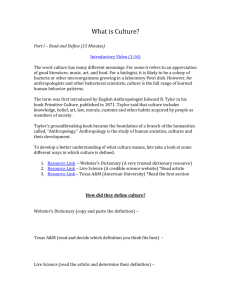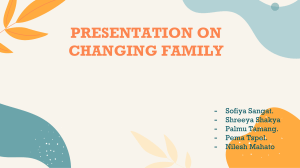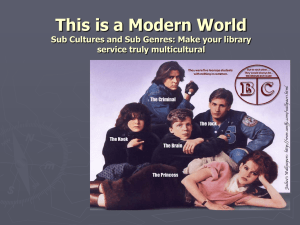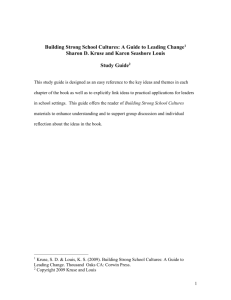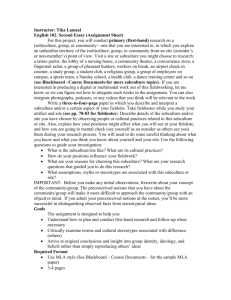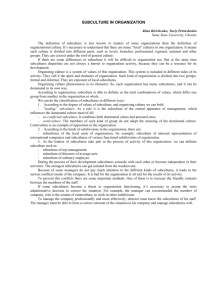Document
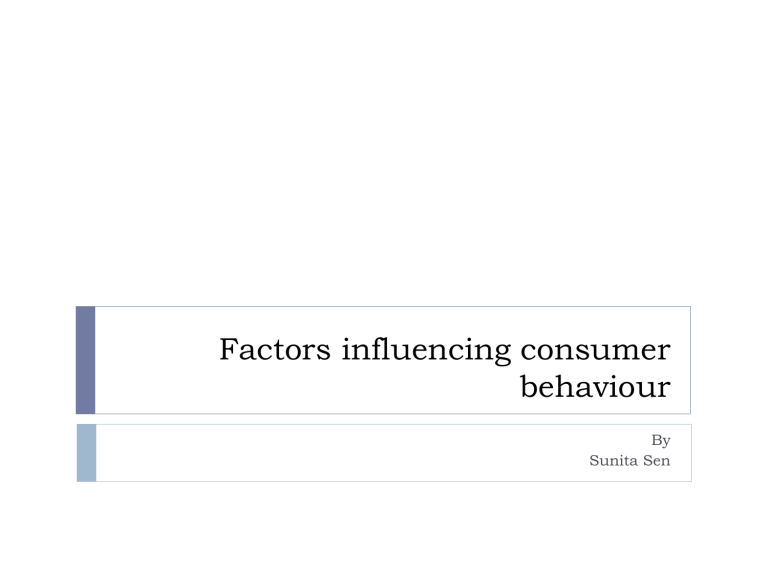
Factors influencing consumer behaviour
By
Sunita Sen
Cultural influence:
A) Cultural and societal influence:
Throughout his existence, an individual will be influenced by his family, his friends, his cultural environment or society that will
“teach” him values, preferences as well as common behaviours to their own culture.
Culture:
Basic values, perceptions, wants and behaviors
Learned from family and important institutions
Cultural values: widely held beliefs that endure over time.
Instrumental values
Terminal values
Features
Culture is a learned response
Culture is shared
Culture is adaptive
Dynamism in culture
B) Subculture
Subcultures are groups of people who share the same values based on a common experience or a similar lifestyle in general.
Subcultures are the nationalities, religions, ethnic groups, age groups, gender of the individual, etc..
Group of people with shared value systems
Based on common life experiences and situations
Marketing to Subcultures
Procter & Gamble targets
Hispanics using print and TV and has developed special Spanish versions of some brands.
Age subculture
Generation Y (1977-94)
Generation X (1965-79)
Baby boomers (1946-64) seniors
Geographic subculture
Religion subculture
Gender subculture
Age subculture
Themes
Purchasing behaviour
Coming of age technology
Price quality attitude
Attitude towards brands
Behaviour towards ads
Generation Y
Savvy, Pragmatic
Computer in every home
Value oriented
Brand embracing
Generation X
Materialistic
MICROWAVE in every home
Price oriented
Against branding
Boomers
Narcissistic
TV in every home
Conspicuous consumption
Brand loyal
Rebel against hype Rebel against hype Respond to image building type
Gender subculture:
Women show superior affect and purchase intention towards ads that are verbal, harmonious, complex and catagory oriented whereas men show superior affect and purchase intention towards ads that are comparative, simple and attribute oriented.
ty
C) Social Class:
Social classes are defined as groups more or less homogenous and ranked against each other according to a form of social hierarchy. Even if it’s very large groups, we usually find similar values, lifestyles, interests and behaviours in individuals belonging to the same social class.
Social comparison theory
We often assume three general categories among social classes:
Lower class
Middle class
Upper class
Measuring social class
1. Subjective measures
Reputational measures
Objective measures:
Single variable indexes
Composite variable indexes
D) Cultural trends:
Cultural trends or “Bandwagon effect” are defined as trends widely followed by people and which are amplified by their mere popularity and by conformity or compliance with social pressure. The more people follow a trend, the more others will want to follow it.
For example, Facebook has become a cultural trend. The social network has widely grew to the point of becoming a must have, especially among young people.
Culture and marketing strategies
Identify key cultural values that affect the consumption of the product
Ensure the marketing mix appeals to these values
Examine changes in cultural values and adapt the marketing mix if needed
Modify marketing mix to subcultures if the culture is heterogeneous
Be aware of symbols and ritual
Measurement of culture
Content analysis
Consumer fieldwork
Value measurement instrument
Content Analysis
A method for systematically analyzing the content of verbal and/or pictorial communication.
Frequently used to determine prevailing social values of a society.
Field Observation
A measurement technique that takes place within a natural environment that focuses on observing behaviour
(sometimes without the subjects’ awareness).
Field Observation
Takes place within a natural environment
Performed sometimes without the subject’s awareness
Focuses on observation of behaviour
Participant-Observers
Researchers who participate in the environment that they are studying without notifying those who are being observed
Value Measurement Survey
Instruments
Rokeach Value Survey (RVS)
A self-administered inventory consisting of eighteen “terminal” values (i.e., personal goals) and eighteen “instrumental” values (i.e., ways of reaching personal goals).
List of Values (LOV)
A value measurement instrument that asks consumers to identify their two most important values from a nine-value list that is based on the terminal values of the Rokeach Value Survey
(continued)
Indian core values:
Family orientation http://books.google.co.in/books?id=ftOqpp6OTc4C&pg=P
A354&lpg=PA354&dq=indian+consumers+core+values&s ource=bl&ots=pxVFzkGOc&sig=MnnfmvTHDBvdm0wub83pgiyTEVU&hl=en&s a=X&ei=4rMzVKrmJcjIuAS9jIKwAQ&ved=0CDIQ6AEwA w#v=onepage&q=indian%20consumers%20core%20values
&f=false
Indian Core values
Values
Values:
Shared beliefs or cultural norms about what is important or right.
Value system
Our total set of values and their relative importance
Cultural values directly influence how
Consumers view and use individual products, brands, and services.
Values
The List of Values (LOV):
•
Self-respect
• Warm relationships
• Self-fulfillment
• Sense of belonging
• Respect from others
• Excitement
• Security
• Sense of accomplishment
• Fun and enjoyment in life
Values
Values and Lifestyles (VALS):
Identifies eight market segments that share similar end values.
Social Factors:
A.
Reference group and membership group:
The membership groups of an individual are social groups to which he belongs and which will influence him. The membership groups are usually related to its social origin, age, place of residence, work, hobbies, leisure, etc.
More generally, reference groups are defined as those that provide to the individual some points of comparison more or less direct about his behaviour, lifestyle, desires or consumer habits. They influence the image that the individual has of himself as well as his behaviour. Whether it is a membership group or a non-membership group.
Reference group:
Normative reference group that influence general or broadly defined values or behaviour.
Comparative reference group that serve as a benchmark for specific or narrowly defined attitude or behaviour.
Indirect reference group
Direct reference group
Major consumer Reference group
Opinion Leaders
Trendsetters – individuals who are more likely to purchase new products early and to serve as information source for others in a group.
Factors that affect reference group’s influence:
Information and experience
Credibility, attractiveness and power of the reference group
Conspicuousness of the product.
Reference group and consumer conformity
Market leaders are interested in encouraging conformity.
Non market leaders re new brands appeal for non conformity
In common marketing usage 5 major reference group are:
Celebrity Appeal
Types
Testimonial
Endorsement
Spokesperson
Definition
Based on personal usage, a celebrity attests to the quality of the product or service
Celebrity lends his/her name and appeal on behalf of product or service with which he/she may or may not be an expert.
Celebrity represents the brand or company over an extended period of time.
The expert
The common man (slice of life commercials)
The executive and employee spokesperson
Trade or spokes-character
Other reference appeals
Seals of approval
Consumer reports
Many brands look to target opinion leaders (initiator or influencer) to spread the use and purchase of their product in a social group. Either through an internal person of the group when it comes to a small social group. Or through a sponsorship or a partnership with a reference leader (celebrity, actor, musician, athlete, etc.) for larger groups.
Family
Family is defined as two or more persons related by blood, marriage or adoption who reside together.
Nuclear family
Extended family
Single parent family
Eight roles in the family Decision-Making
Process:
Influencers: provide information to other members
Gatekeepers : control the flow of information
Deciders: have power to determine unilaterally or jointly whether to buy or not
Buyers: make actual purchases
Preparers: transform products into form suitable for consumption
Users: use the product or service
Maintainers: service or repair the product for continued satisfaction
Disposers: carry out disposal or discontinuation of the product.
